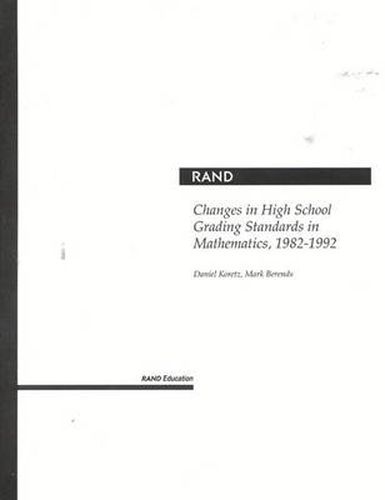Readings Newsletter
Become a Readings Member to make your shopping experience even easier.
Sign in or sign up for free!
You’re not far away from qualifying for FREE standard shipping within Australia
You’ve qualified for FREE standard shipping within Australia
The cart is loading…






Observers recently have maintained that grades in secondary and postsecondary institutions have become inflated. Grade inflation would be troubling to many K-12 educators and policymakers but this possibility is an especially serious concern to many colleges and universities because such inflation could bias their admissions decisions and make it increasingly difficult for them to distinguish among high-achieving students. This study examines this possibility by evaluating changes in high school grading standards across the nation as a whole from 1982 to 1992. The authors examined not only changes in the grade distribution over time but also changes in the educational system and in the characteristics of the student populations. They investigated how grades have varied between males and females, minorities and nonminorities, and poor and rich students; trends in grading standards across types of schools; relationships between grades and student performance on achievement tests; and the influence on grades of changes in tested proficiency and course-taking. The authors detailed analysis concluded that no such grade inflation has taken place, at least in mathematics, over the study period.
$9.00 standard shipping within Australia
FREE standard shipping within Australia for orders over $100.00
Express & International shipping calculated at checkout
Observers recently have maintained that grades in secondary and postsecondary institutions have become inflated. Grade inflation would be troubling to many K-12 educators and policymakers but this possibility is an especially serious concern to many colleges and universities because such inflation could bias their admissions decisions and make it increasingly difficult for them to distinguish among high-achieving students. This study examines this possibility by evaluating changes in high school grading standards across the nation as a whole from 1982 to 1992. The authors examined not only changes in the grade distribution over time but also changes in the educational system and in the characteristics of the student populations. They investigated how grades have varied between males and females, minorities and nonminorities, and poor and rich students; trends in grading standards across types of schools; relationships between grades and student performance on achievement tests; and the influence on grades of changes in tested proficiency and course-taking. The authors detailed analysis concluded that no such grade inflation has taken place, at least in mathematics, over the study period.